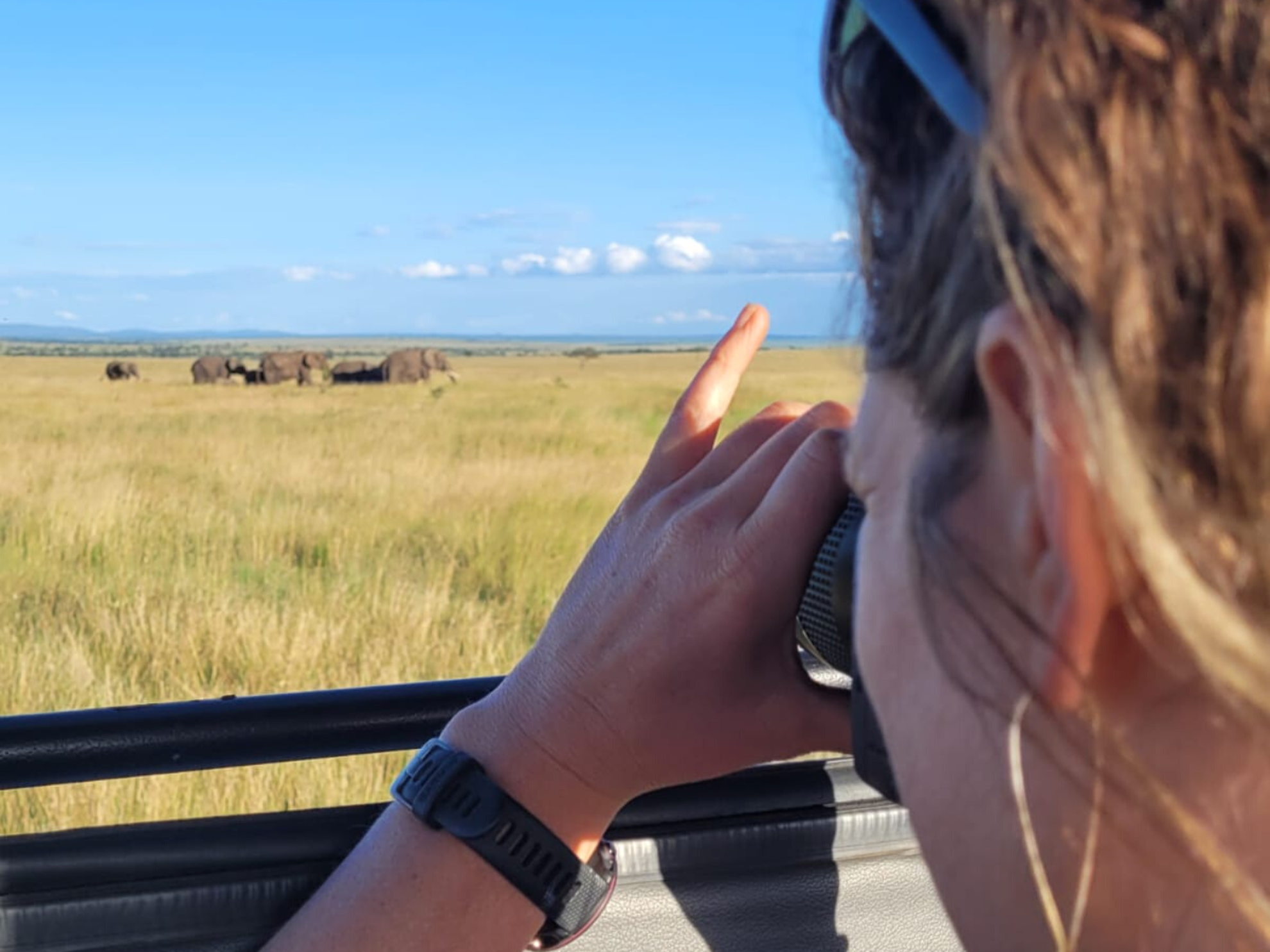
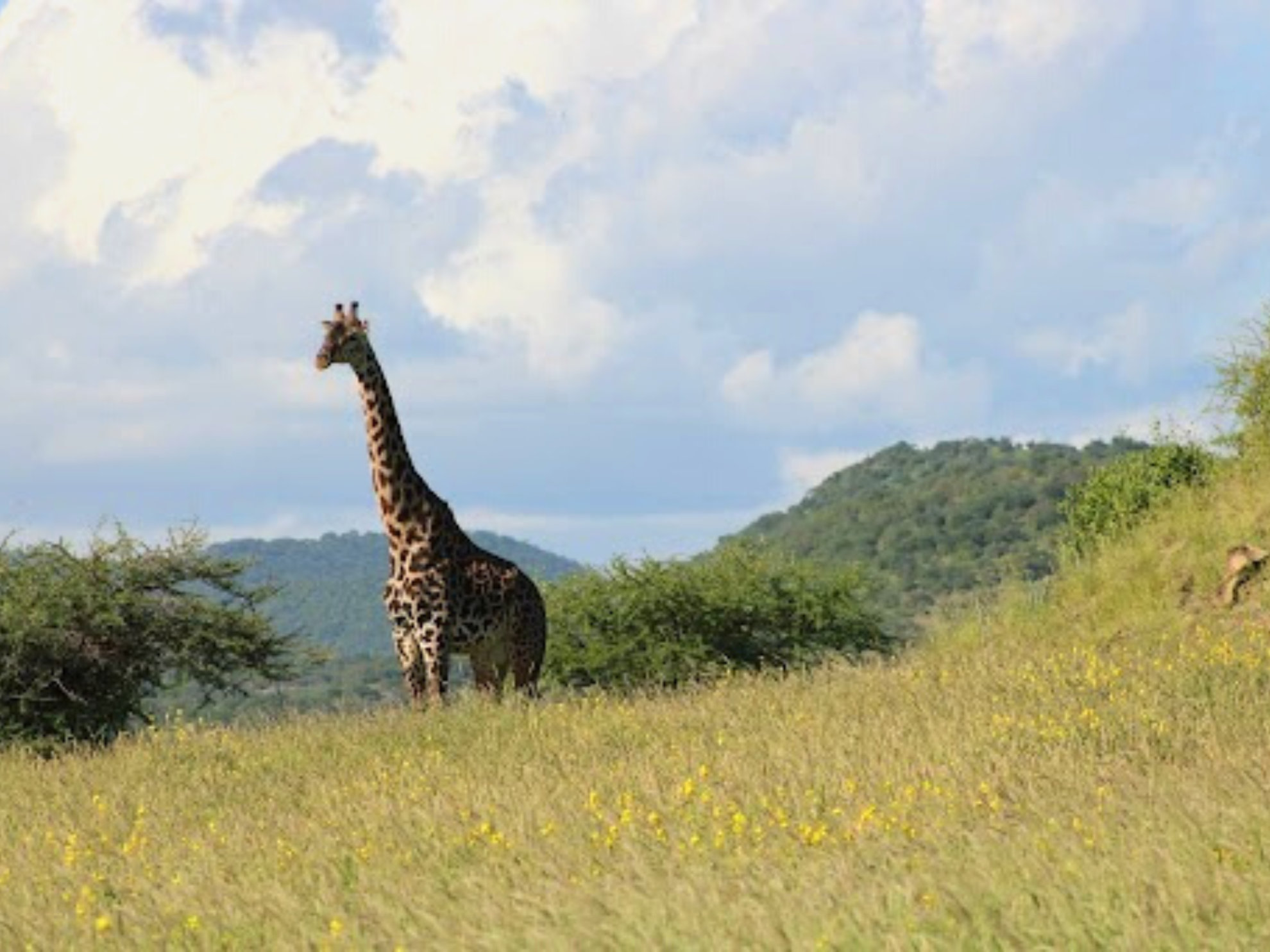
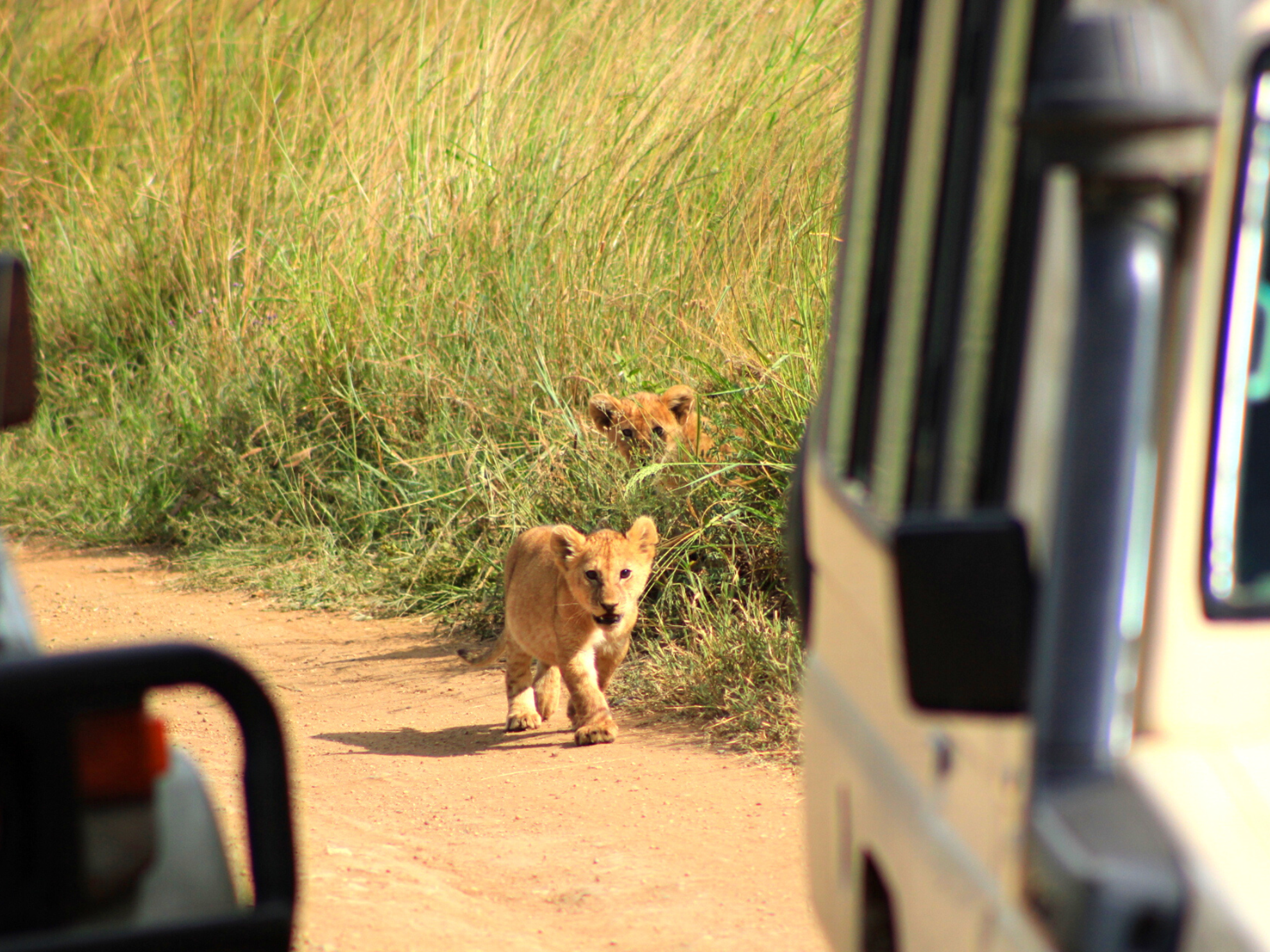

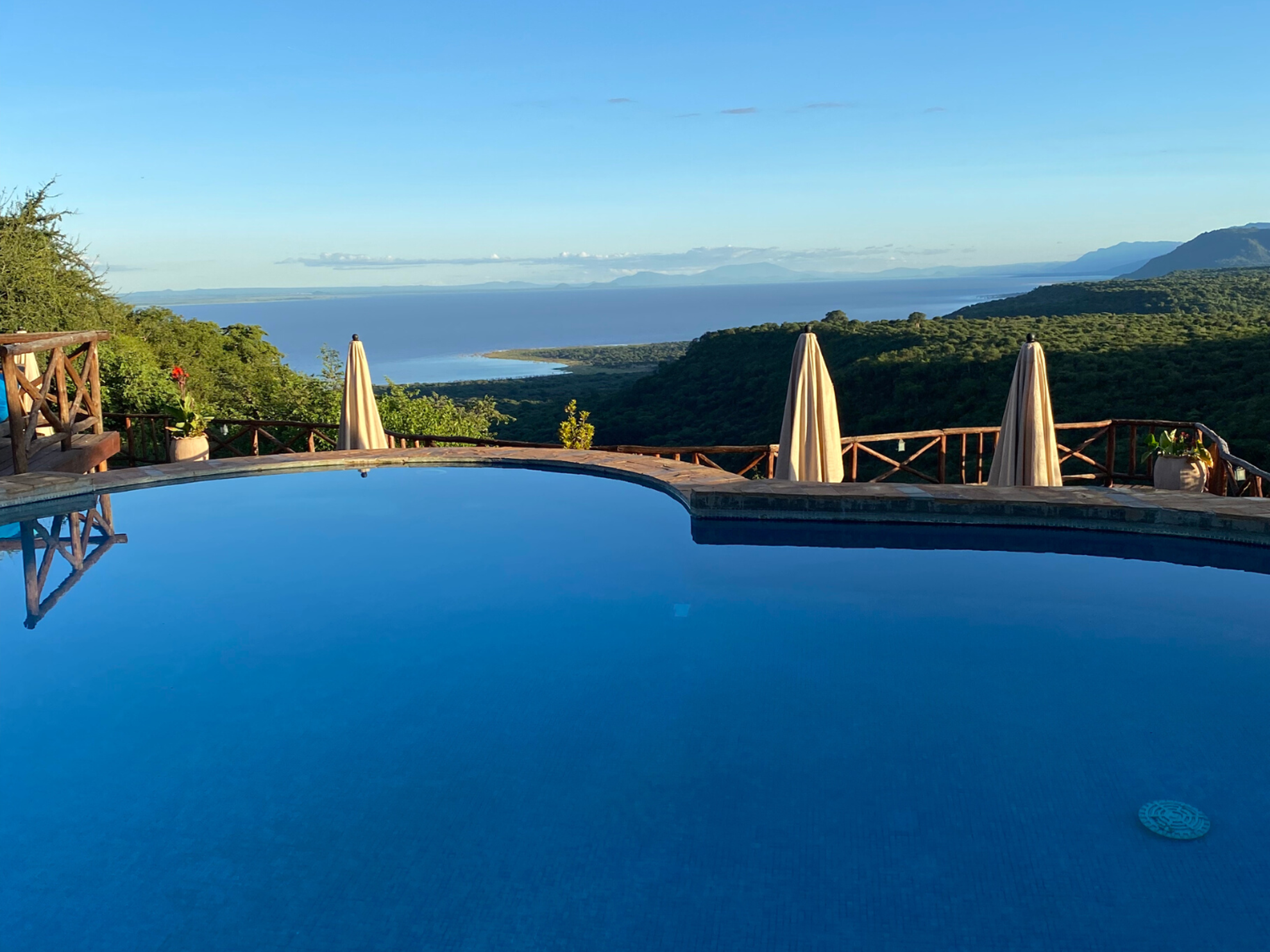
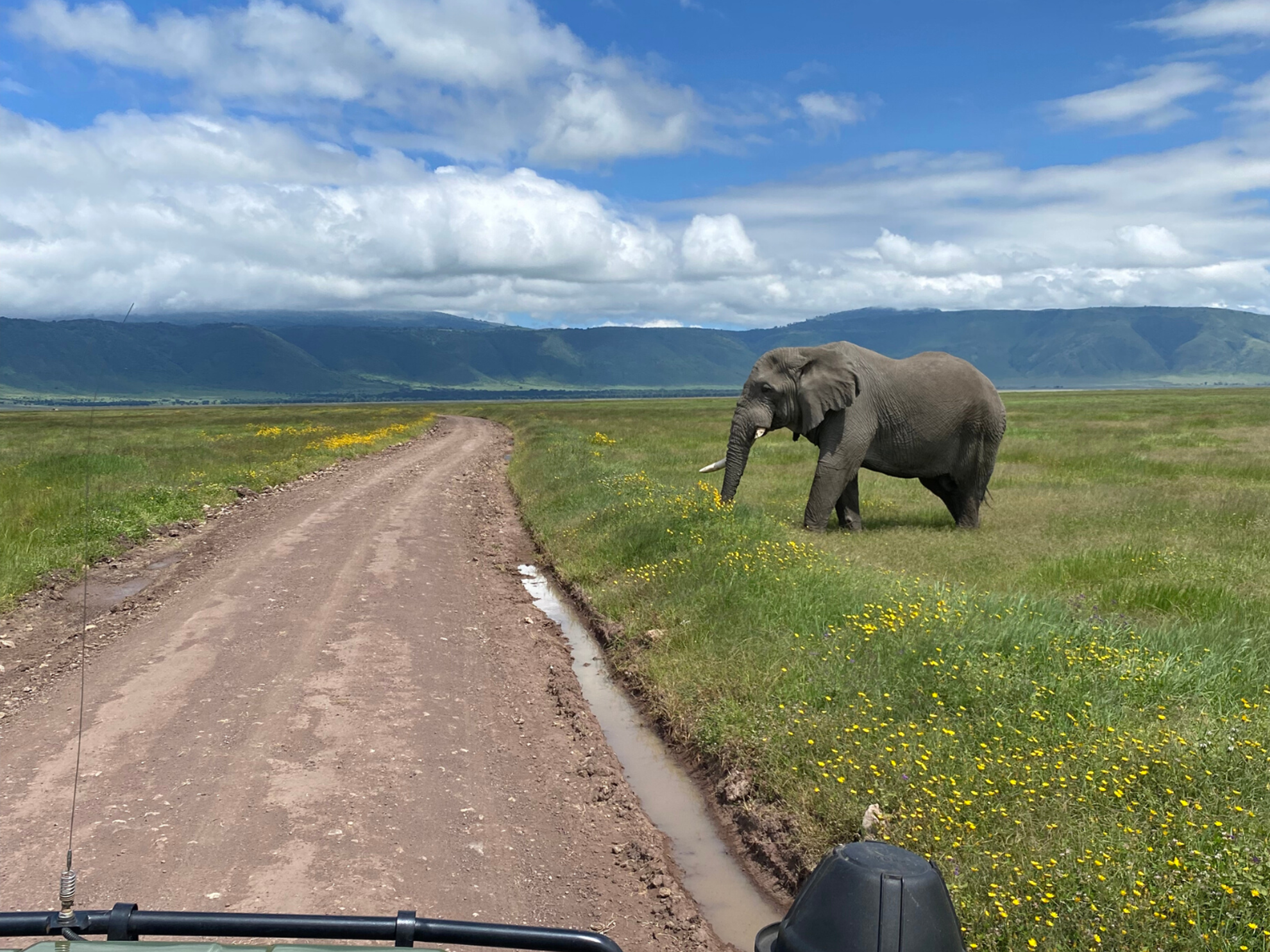
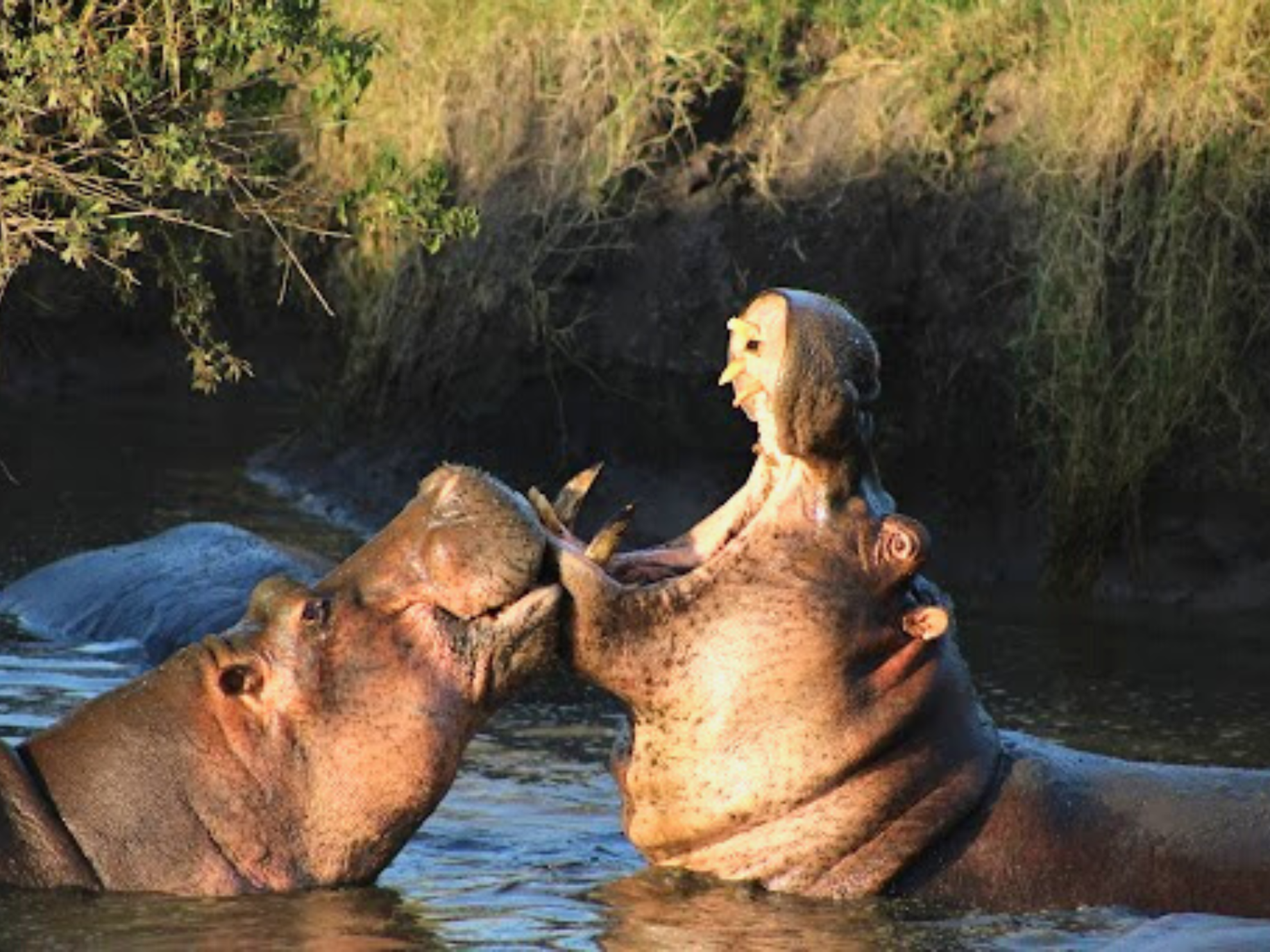
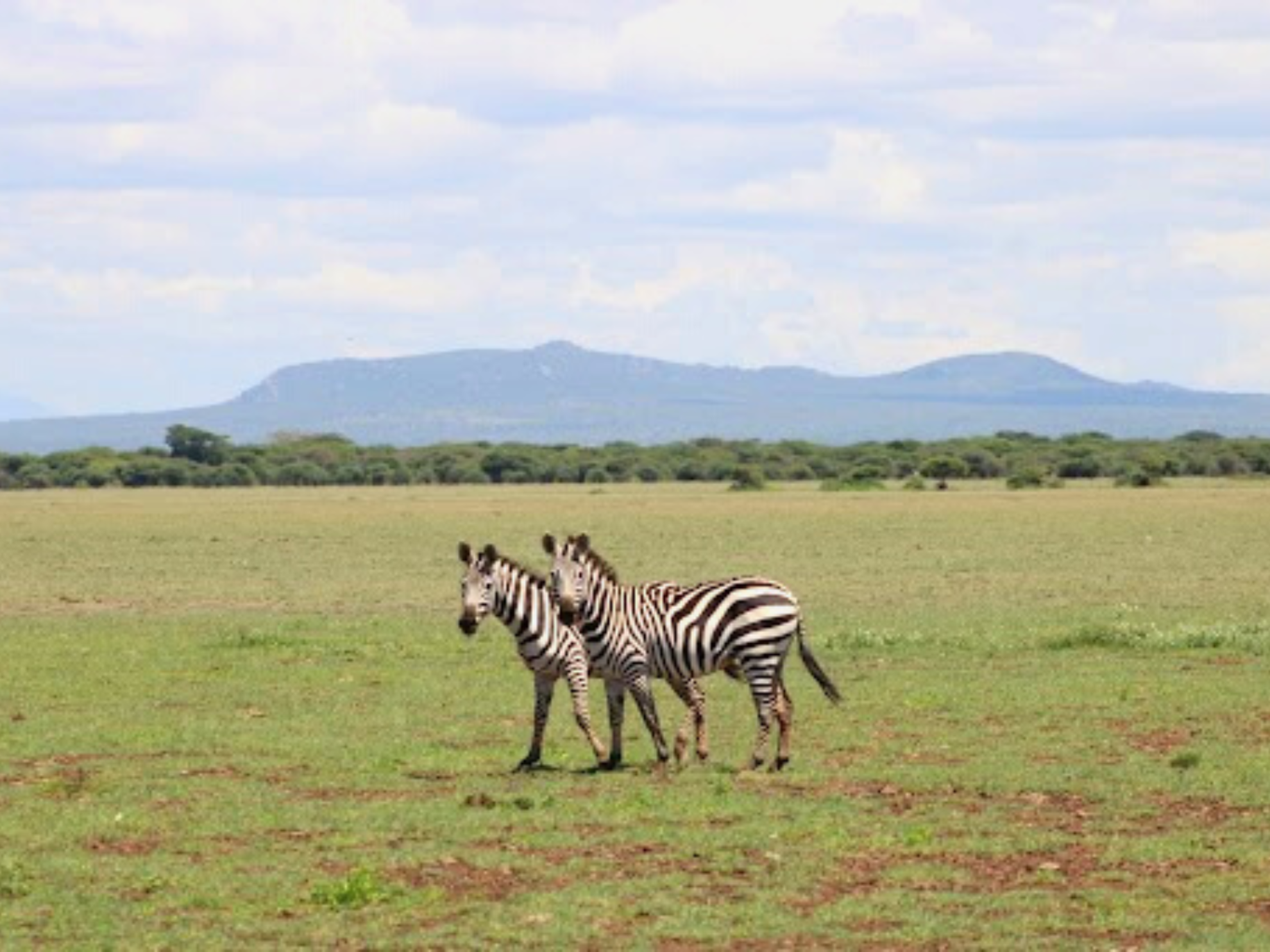
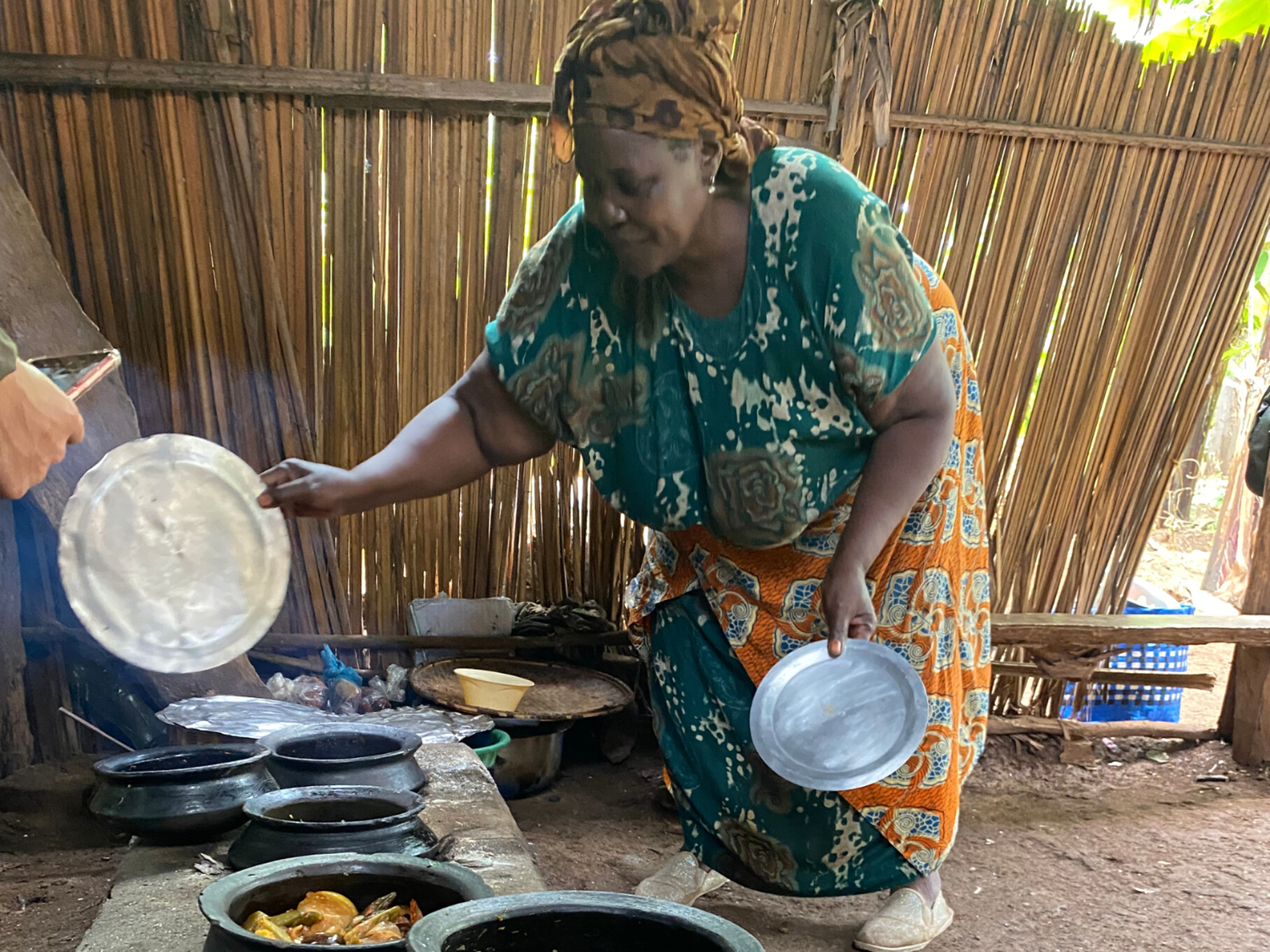

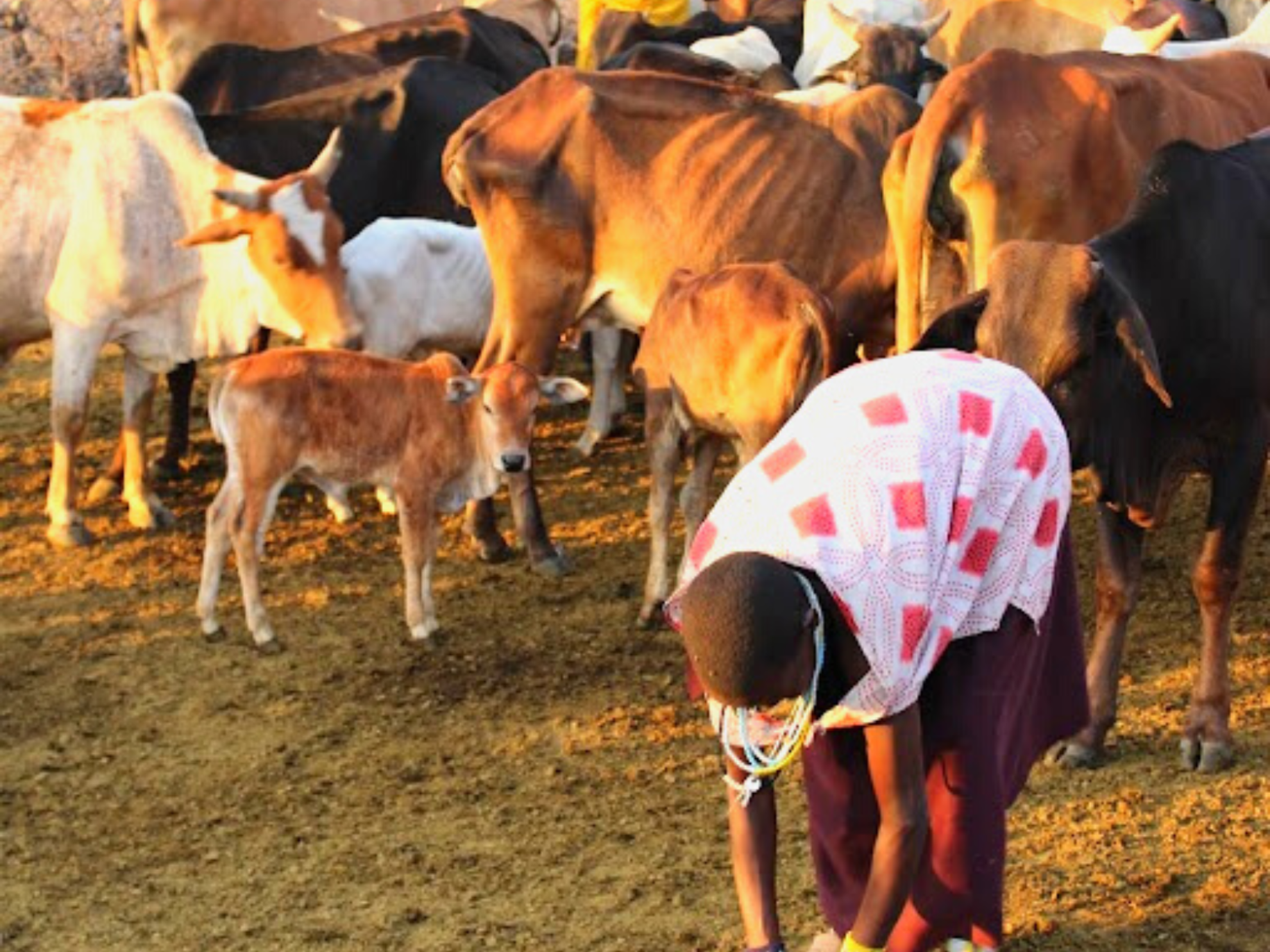
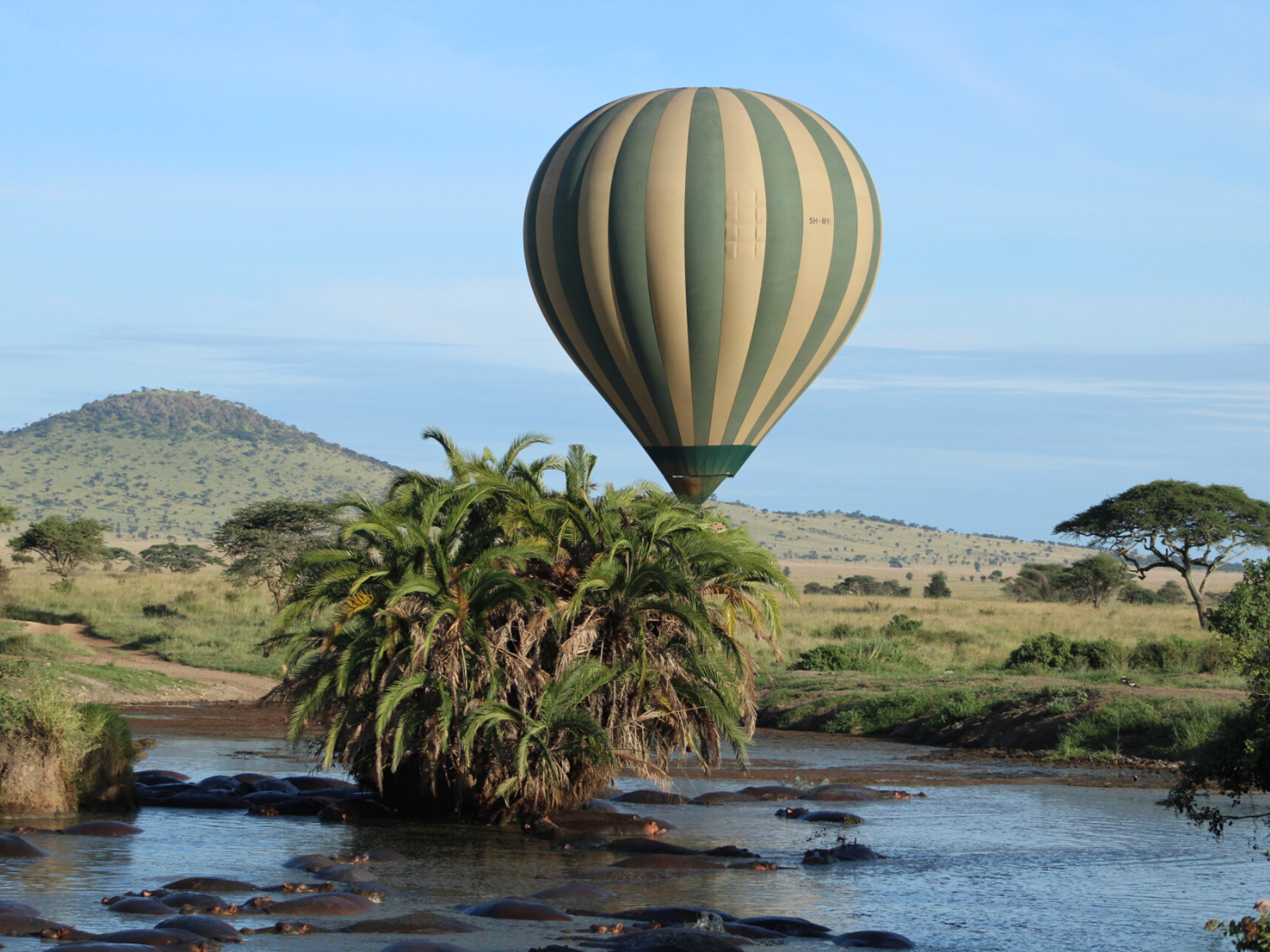
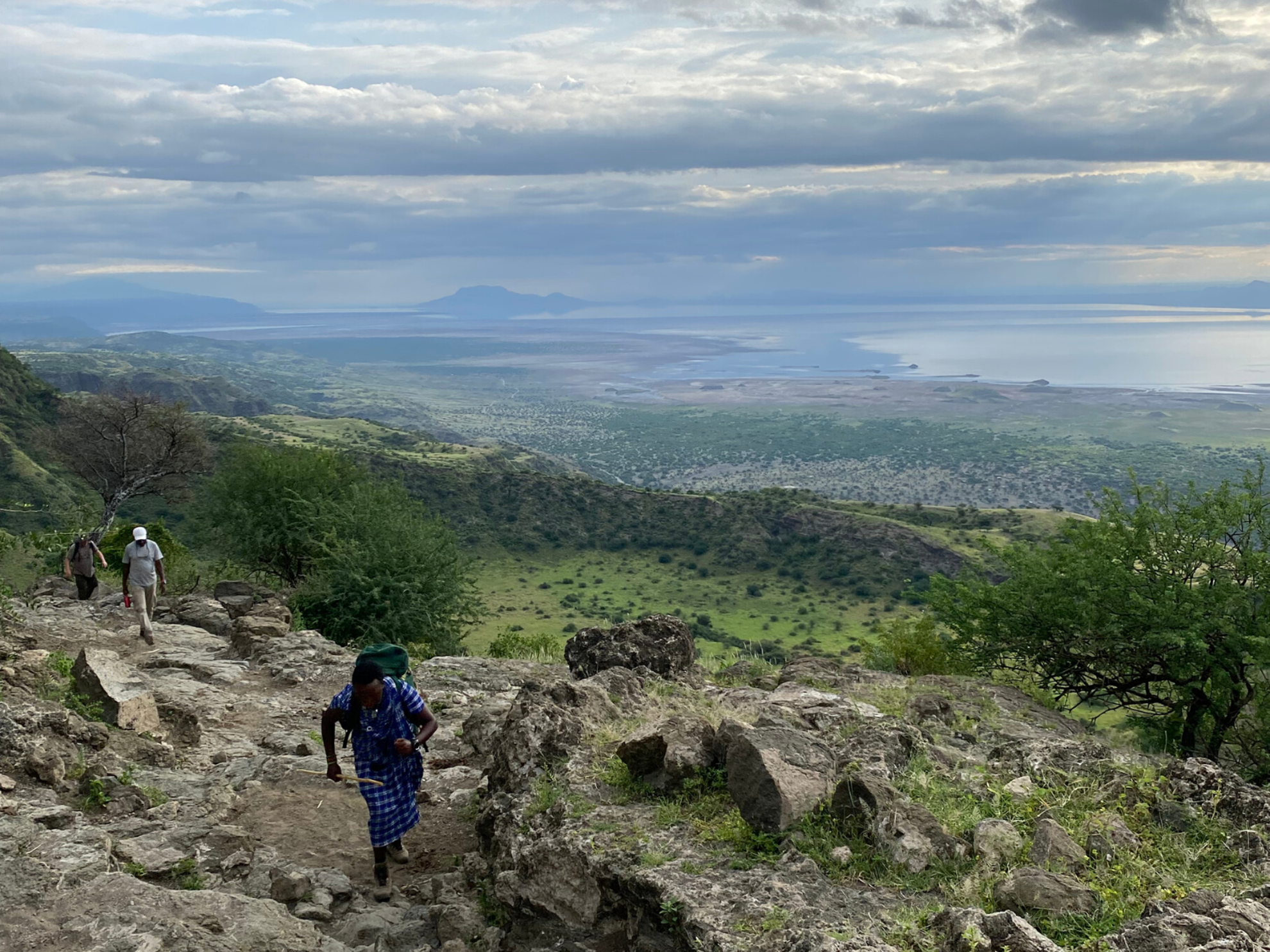
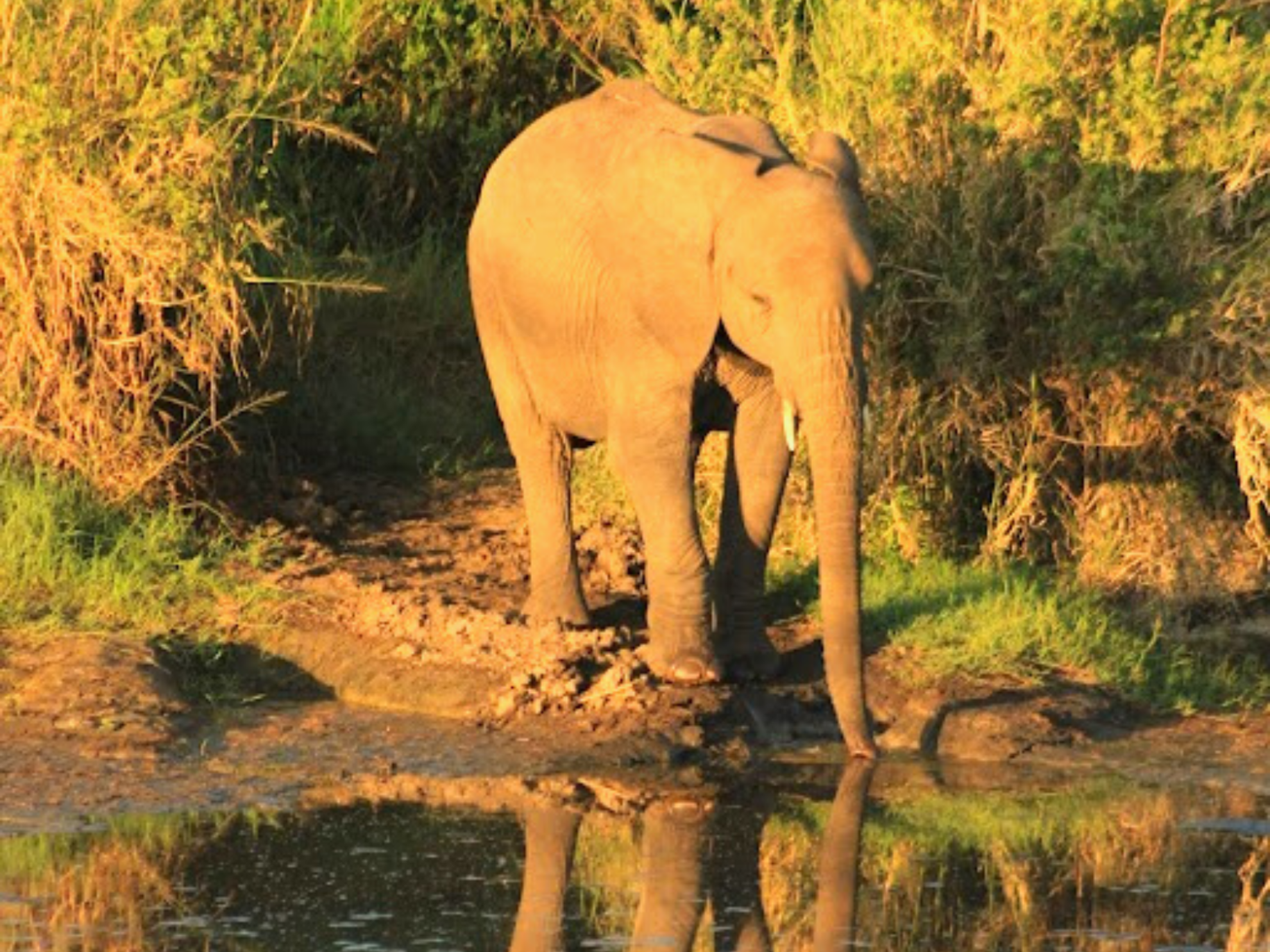
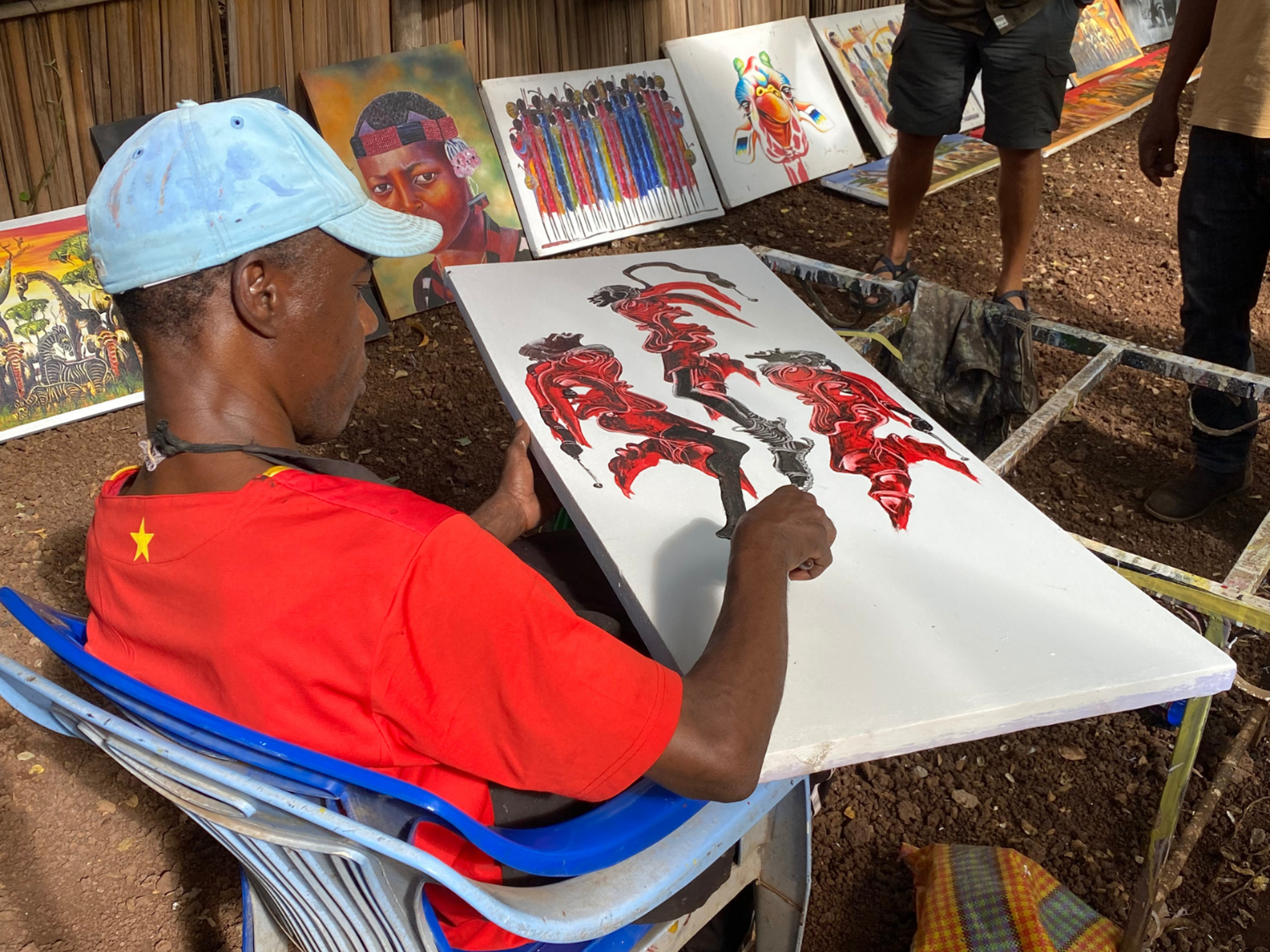
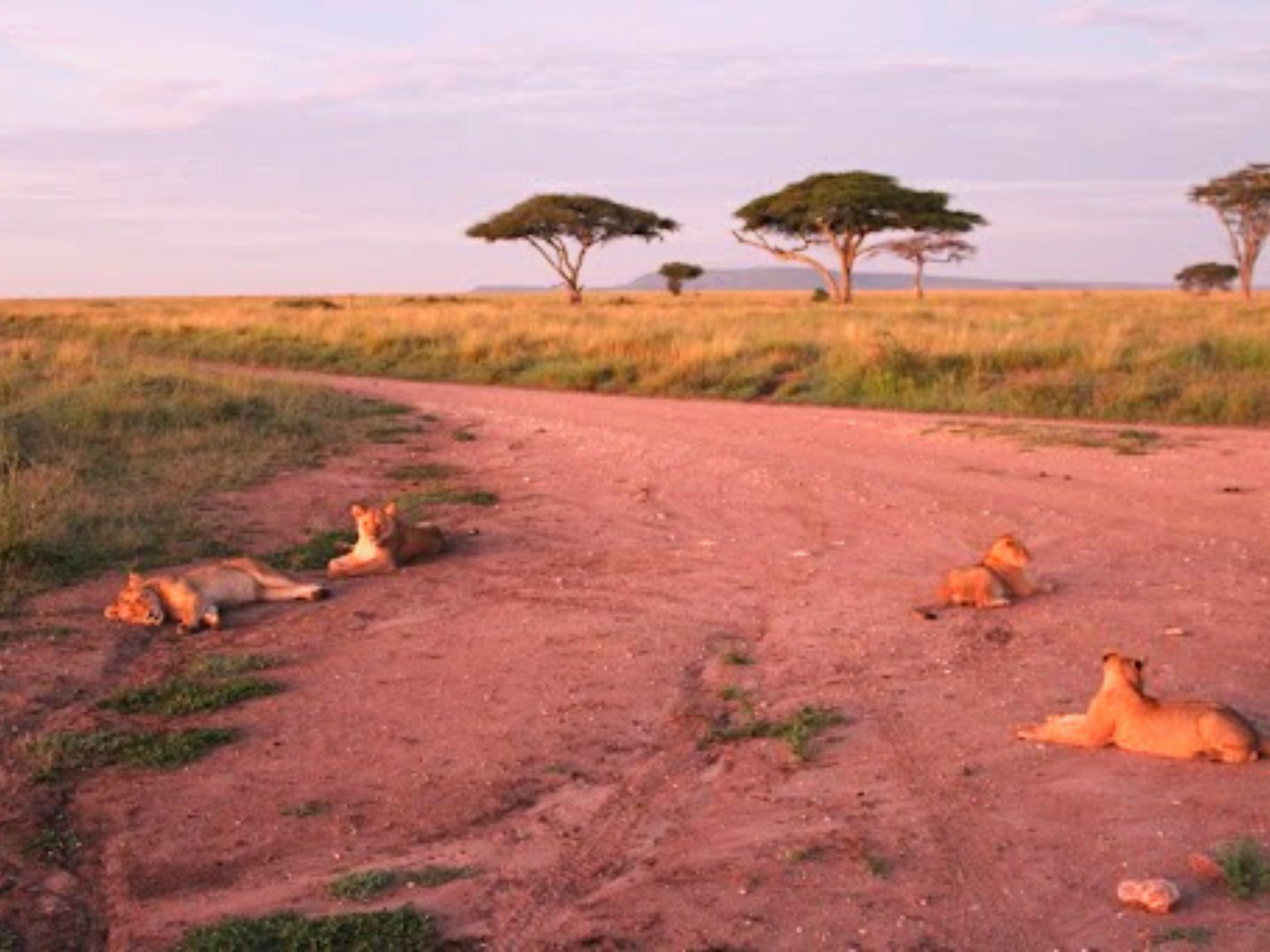
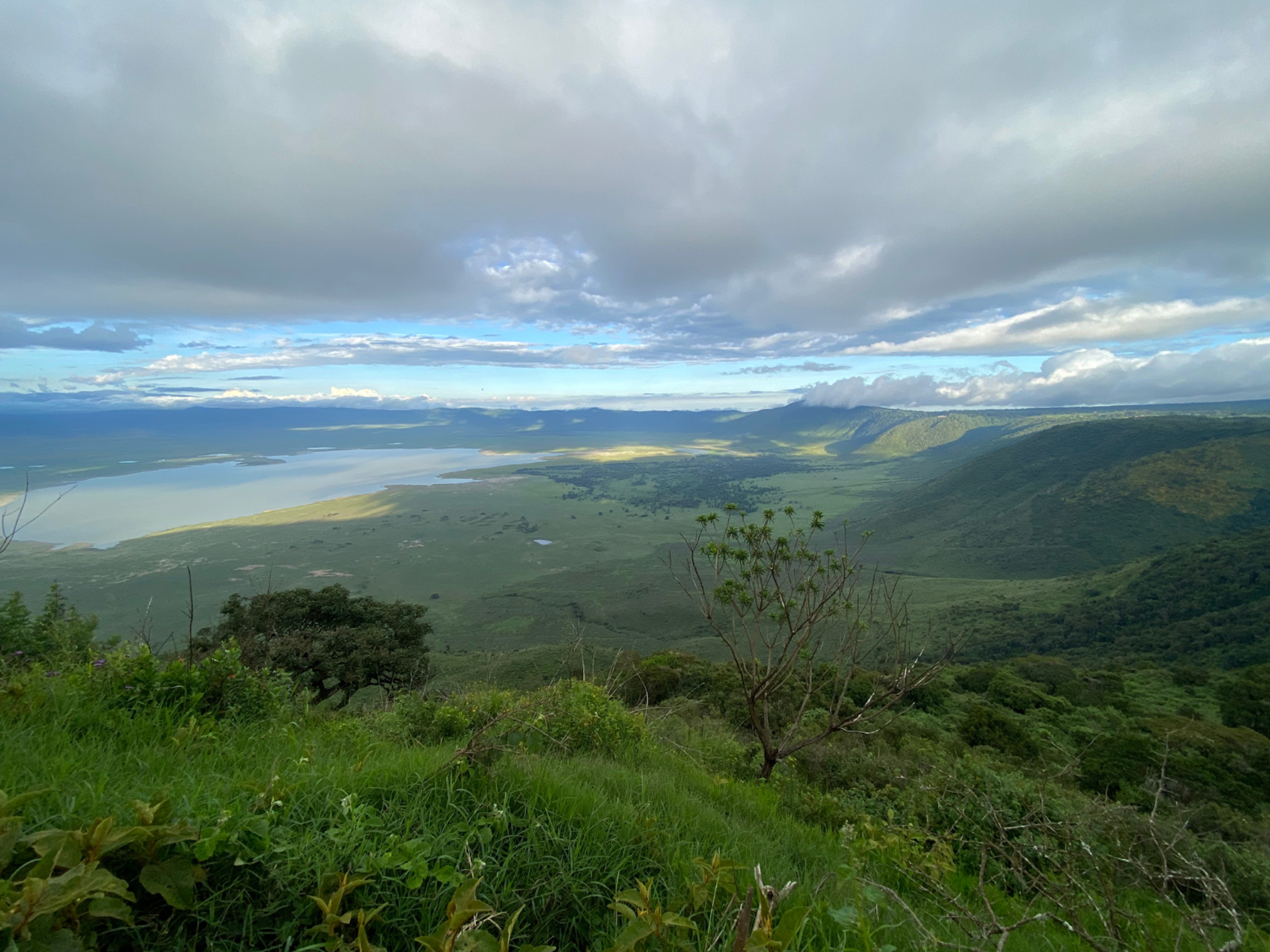
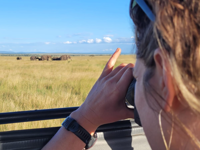
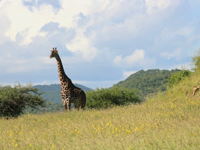
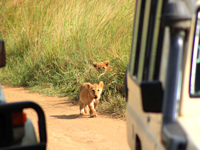
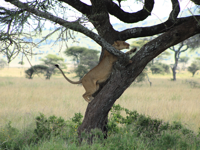
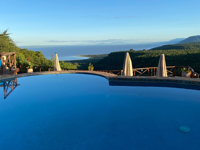
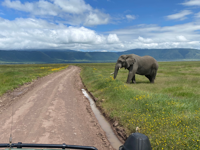
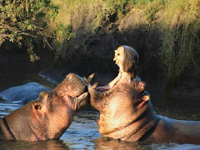

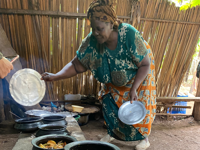
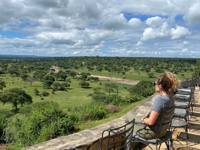
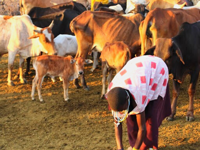
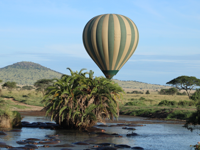
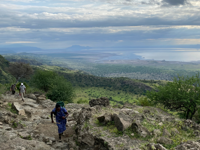
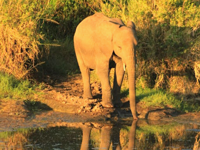
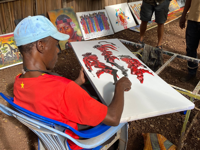
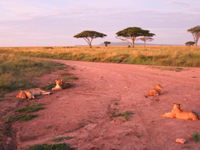
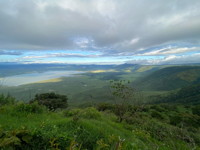

Join us in Tanzania for our Ngorongoro Highlands Trekking and Serengeti Great Migration Safari trip. We will spend two weeks traveling, trekking, and experiencing the best of Northern Tanzania. On this adventure, we do it all: from multi-day trekking, to safari, to cultural connection! You will get off the beaten track on a three-day, 2 night glamping, camping, and trekking journey through the Ngorongoro Highlands discovering the real Tanzania on foot. With our local naturalist guides with us, we are sure to spot beautiful local animals like zebra, flamingos, and giraffe! On either side of the trek, we will be learning all about Tanzanian culture through cultural experiences and multiple days of safari drives. First up is Tanzania's Tarangire National Park where we will spot wildlife on a night game drive, then hike through Lake Manyara National Park and learn about medicinal herbs on a walk around the park, trek through the Ngorongoro Highlands, and spend the final days of the trip in the famous Serengeti National Park to take in the sights of the Great Migration and the elusive Big 5 of Tanzania: lions, leopards, buffalo, elephants, and rhinos! Each night, relax and enjoy the famous African sunsets during your sundowners.
Maximum group size: 12
Please note: 2025 and 2026 itineraries vary slightly. Our 2025 itinerary takes us into the northern Serengeti while 2026 is in the central Serengeti. See Trip Summaries for details.
Not included: alcoholic beverages, optional sunrise hot air balloon excursion, transportation to and from Tanzania, guide gratuities and trip insurance (mandatory).
Trip Info
This trip is for women in good physical condition who enjoy trekking in a beautiful setting while learning about the history, culture and ecology of Tanzania. Although for the most part, the hiking is moderate, you will have a few long days in the highlands. The other half of this trip will be on land safaris driving through multiple national parks and wildlife reserves. This trip is designed for women in very good physical condition who enjoy hiking and other activities and want to explore Tanzania. Hiking is generally 3 - 7 hours on dirt trails, rocky paths, and occasionally uneven footing. A rating of 3 requires aerobic conditioning, such as walking vigorously up hills, jogging, cross country skiing or stair stepping for 30 - 45 minutes at least 3 - 4 times a week. For this trip you should be working out at the upper end of these ranges.
Rating: 1 2 [3] 4 5.
This trip is for women in good physical condition who enjoy trekking in a beautiful setting while learning about the history, culture and ecology of Tanzania. Although for the most part, the hiking is moderate, you will have a few long days in the highlands. We will be doing one day hike in Arusha National Park before our 3-day, 2-night trekking journey in the Ngorongoro Highlands. A few days of our journey will be experiencing cultural activities like traditional cooking classes, a medicinal herbal walk, walking tours of local villages, and a morning spent with a Maasai tribe. Four days will be spent on safari drives! The safari drives are usually very exciting, but also inactive, as we are unable to leave the jeep while we are in national parks. We will be in a safari jeep for all of our drives throughout the trip. The roads will be bumpy, but it will be an adventure!
While in Moshi, we will stay at a modern hotel just outside of town with ensuite bathrooms. In Tarangire National Park, you will stay in Tarangire Safari Lodge, one of the most historic camps in the area, with an amazing deck view of the Tarangire River. You can watch elephants and giraffes rest and drink at the river throughout the day. We will spend two nights at the Acacia Farm Lodge with hot water, ensuite bathrooms, and panoramic views from your terrace or balcony. While on the trek, all your camping gear will be carried by porters. Each night your tent will be set up with cots, sheets, blankets, and pillows. While you won't be able to shower while on the trek, hot water will be available for you to wash up every morning and evening. While at Natron, we will be staying at Lake Natron Halisi Tented Camp. This camp has bucket showers (common for tented camps and function like regular showers), compostable toilets, and fresh water available for washing hands and brushing teeth. While in Serengeti, we will be staying at Nikyani Migration Camp Kogatende with amazing savannah views. Each tent has ensuite bathrooms, flush toilets, and bucket showers. You will be able to do laundry at most of the Lodge accommodations.
Trip Resources
Below is the proposed itinerary for the trip. As is true on any adventure travel trip, plans for any specific day may be modified due to weather considerations, unforeseen circumstances, new opportunities, and group interests.
Depart Moshi heading north eastwards to the Arusha National Park. Despite its small size, this park has a rich variety of wildlife and within its three vegetation zones, many different kinds of animals can be found. The Mount Meru eco-system is especially diverse and home to some of the more elusive larger mammals, such as leopard and hyena. Almost 400 species of birds have been recorded in the park, some of which are migratory and only present between October and April, whilst others are permanent residents.
After a game drive, we will take a three-hour hike through the park, accompanied by an armed ranger, offering a freer way to enjoy the park and its nature away from the usual safari game driving. There are several walking routes we can choose from and these can be discussed in advance with the safari guide. We had a wonderful and big day in the park, and our hotel is just outside Arusha city, where we will have dinner and stay overnight at the lush Tumbili Lodge.
Hiking: 3 hours
Overnight: Tumbili Lodge, Arusha (B, L, D)
In the morning, we begin our drive to Tarangire National Park, taking a game drive on route and arriving for lunch at Tarangire Safari Lodge. After lunch, we return to the bush for another game drive in the park. Tarangire is famous for its unique backdrop of large baobab trees and its dotting of large termite mounds! Enjoy watching the park’s huge herds of elephants, and even spot a baby or two. Throughout the dry season, thirsty antelope and elephants trek hundreds of kilometers to drink at the Tarangire River. Also home to more than 550 bird species, the park will excite any bird enthusiast.
Late afternoon, head to the strategically located Tarangire Safari Lodge, overlooking the Tarangire river bed and giving great views of the park and its resident wildlife. A sundowner drink on their clifftop porch is a must.
Take advantage of our only night game drive in Tarangire National Park. Though the sun may have set, Tarangire is still not asleep. After an early dinner, you can take a night game in the park in an open vehicle, accompanied by an armed ranger, specialist guide, and a tracker. This is a thrilling and adventurous sensory experience where you can discover the nocturnal wildlife of the national park and tune into the night sounds and movements of the park, whilst stargazing. Drive into the pitch black of the night to see animals, some of which are rare and inactive during daytime, including porcupines, genet, and civet cats. If we are lucky, we get to see prowling lions and the elusive leopard, both of which are active in the night rather than daytime.
Overnight: Tarangire Safari Lodge (B, L, D)
After a more leisurely breakfast, take an on-route game drive in Tarangire National Park as you exit the park and continue to the town of Mto Wa Mbu, literally meaning River of Mosquito, adjacent to Lake Manyara National Park. Isoitok Camp Manyara is a tented camp deeply connected with the community and offers grassroots cultural immersion opportunities within the local Maasai community. After lunch at Isoitok, take an afternoon guided Maasai medicine walk. Here, you will learn about the different root and plant extracts still being used by the Maasai people on a daily basis. Visit an Orpul (healing retreat) area where young warriors learn an age-old tradition from their elders and the medicine man of the village. This gives you a deeper understanding of the real Maasai culture.
Next, drive to the well-known and amazing FAME hospital in the highlands town of Karatu for a tutorial and talk about their inspirational story. Hear about the founders and how they realized their dream of building such an ambitious hospital in Tanzania and learn about its humble beginnings with simple outreach clinics in remote areas. Mid afternoon head to Acacia Farm Lodge for some relaxation, followed by dinner and overnight stay.
Overnight: Acacia Farm Lodge (B, L, D)
In the morning, we head to the town of Mto Wa Mbu for a cultural immersion experience. Mto Wa Mbu is home to some of the different people of Tanzania, notably the Mbugwe, Iraqw, Gorowa, Irangi, Chagga and Maasai, a lot of different peoples of Tanzania living alongside each other. A local guide from the Mto Wa Mbu Cultural Tourism Program will walk with you through the backstreets of the town. Each day is different in Mto Wa Mbu, and you will get an understanding of the daily lives of people living around this area. You may visit a Chagga family who grows bananas and brews banana beer, or a farmer from Kigoma who makes palm oil presses. Alternatively, a walk towards the Papyrus Lake brings encounters with the Rangi people who collect materials from the lake to make baskets and mats. On the way through town, you may meet rice farmers and visit Sandawe families who still make traditional bows and arrows for hunting. The Makonde family of artists, from Mozambique, will introduce everyone to the skills for carving wood, which are passed down through families from generation to generation. The morning ends with a delicious homemade Tanzanian meal prepared by a local women's group using traditional methods and made with local and indigenous vegetables and spices!
Next, we drive towards the highlands town of Karatu. Enroute, we stop at a museum to learn about Tanzanite- why it’s so rare and sought after, the conditions in which it was formed and the complexities involved in its mining, the skills involved in cutting and polishing as well as enjoy the stories and myths surrounding the gemstone. We will have an opportunity to purchase Tanzanite jewelry and other local crafts.
After lunch we return to Karatu to the Acacia Farm Lodge for some afternoon rest and relaxation or a swim in the pool. Dinner and overnight stay here for a second night.
Overnight: Acacia Farm Lodge (B, L, D)
We will wake up early in the morning, and depart from our lovely home in Lake Manyara, passing the highlands town of Karatu, then on to the Ngorongoro Conservation Area, a UNESCO World Heritage Site. The Ngorongoro Conservation Area is also considered one of the natural wonders of the world! The conservation area is unique in that it allows well over 40,000 Maasai pastoralists with their cattle goats and sheep to live alongside the abundant wildlife in a natural setting. Descend into the Ngorongoro Crater for a game drive, including a picnic lunch in the crater. Ngorongoro Crater is the world’s largest caldera measuring 1,968ft in depth and covering 96.5 sq mi in area. It is a spectacular setting and contains an abundance of wildlife with over 20,000 large animals including Tanzania’s remaining critically endangered black rhino. There is a good chance of seeing the Big Five in this vast natural enclosure!
We soon head northwards to the Nainokanoka Ranger Post and onwards to the Ngorongoro Highlands. We will be able to spot Olmoti Crater and Mount Lolmasin, Tanzania's third tallest mountain. Picturesque raw and lonesome landscapes emerge as we head towards the Empakaai Crater, one of the multi volcano calderas and geographical beauties of the Ngorongoro Conservation Area. Empakaai elevation at its maximum point is 10,500 ft above sea level and with this high altitude, the rim is always misty, whilst the lake in the crater appears emerald or deep blue. Here, we will meet our trekking staff for the next few days! They will have set up camp for us on the crater rim at Empakaai’s Special Camp for the night. Take a short nature walk around the rim. Bushbuck, buffalo and blue monkey can be seen on the rim, which boasts superb views on a clear day northwards to Ol Doinyo Lengai volcano, Lake Natron, as well as the dramatic Great East African Rift Valley. Enjoy a hearty camp dinner around a campfire, whilst watching the stars twinkle in the dark African sky.
Empakaai Crater walk: 2.8 miles, 978 ft descent/ascent - 2 hrs round trip
Overnight: Tented Camping, Empakaai Crater (B, L, D)
Today begins our Ngorongoro Highlands trek! This remote trek with fresh air, peace, and tranquility in the wilderness, offers the world's most stunning sights: misty forests and rolling hills, ancient craters and colorful blazes of Maasai who inhabit this unique land. You will be rewarded with striking views of ancient and recent volcanic mountains, including Mt Lolmasin, Gilai, Mt Kilimanjaro and Mt. Meru. Whilst trekking, your guides will carry the tents, cooking equipment, and luggage, while you have your day pack with water, layers, and snacks! An armed ranger will also accompany the group for safety whilst you trek in the Ngorongoro Conservation Area. Each day will be an approximate 5-7 hour trek. Wake up to an aromatic coffee and enjoy a delicious breakfast prepared for you by the team’s cook before packing up for the day.
Descend by foot into Empakaai’s crater floor, a 984ft descent. Take time to appreciate the lush landscape and wildlife in this crater, which is famous for the pink flamingos that congregate here, turning the lakeshore a pretty pink. After exploring the rainforest inside the crater, we begin our ascent out of the crater. You meet the Maasai herders and their donkeys, who will carry all of our gear to the next camp. We trek downwards into the highland meadows to the small Maasai village of Nayobi, a trading center for the local communities. Here, we will take a short rest and have a delicious picnic lunch prepared by their cooks.
We end our hike today at Acacia camp. This campsite is set under these yellow-barked acacia trees, with magnificent views of Ol Doinyo Lengai, the Maasai Mountain of God.
Empakaai to Acacia Camp: 10.4 miles – 5hrs hiking
Elevation gain 1,053’, Elevation loss 2,838ft
Overnight: Tented camping at Acacia Camp. (B, L, D)
After an early breakfast, trek into the Rift Valley. As the group follows the edge of the Great East African Rift Valley Escarpment wall, Lake Natron shimmers in the distance ahead whilst the volcano Ol Doinyo Lengai dominates the view eastwards. We will learn all about the Rift Valley walking through this dramatic geological landscape. We will follow a trail downward along an ancient trading route to the foot of Lengai. For centuries, this road has been used by the Maasai on the lower plains near Lake Natron to trade their goods with the Maasai of the Ngorongoro Highlands. Upon reaching the bottom of the escarpment wall, safari vehicles will be waiting for the group to transfer you to our tented base camp for the night.
Lake Natron Halisi Tented Camp is a camp run by Maasai from the local community. You will enjoy a much deserved al fresco lunch and a cooling shower. The afternoon can be spent taking rest at the camp and recovering from the trek. Alternatively, opt to take a short walk to the creek behind the hill next to the camp. Under this secluded shaded space trekkers can refresh their feet by dipping their legs in this creek and relax here, with a drink in hand! Later, we enjoy our sundowner on a hilltop with magnificent views of the valley, and celebrate a job well done!
Hiking: 6.2 miles, 4 - 5 hours, Elevation gain: 240 ft; Elevation loss 3,133 ft
Overnight: Lake Natron Halisi Tented Camp (B, L, D)
After a leisurely morning, we take a walk to see the scenic Lake Natron, an almost surreal giant alkaline lake which is part of the Rift Valley chain of soda lakes. Set at an altitude of 2,000ft, below the Rift Valley Escarpment, Lake Natron offers incredible bird and game viewing. It is the only breeding ground for East Africa’s millions of flamingos, who usually congregate to breed here between August and October. Witness the age-old practice of extracting dried alkaline crust (Magadi) from the lake bed and how it is used medicinally and as a nutritional supplement for cattle and local cooking. From here, drive to the Hominid Footprints to see some of the oldest footprints of Homo Sapiens, dating about 120,000 years. There are more than 400 footprints crisscrossing the dark gray mudflat near the lake.
After a delicious homemade lunch, we head to the Ngare Sero waterfalls oasis for a refreshing afternoon canyon walk! Walk through the rocky Ngare Sero River Gorge via the Saitoti River Trail until you reach the waterfalls, which is fed through underground water springs all the way from Ngorongoro Highlands. Take a natural shower in the waterfalls, plunge in the natural pool and relax in its cooling water.
Late afternoon, return to the camp. We finish our evening with a celebratory traditional Maasai goat BBQ and campfire. Try your hand at spear throwing the Maasai way, traditional fire making and sampling the various soups/teas Maasai drink to complement their health and wellbeing. Enjoy the warm light of the fire while listening to the crackling of firewood and the distant sounds of hyenas.
Waterfall hike: 2.2 miles; elevation gain: 377'.
Overnight: Lake Halisi Tented Camp (B,L,D)
We start our day with an early morning wake up to visit the local Maasai boma (homestead), a cultural immersion opportunity to understand the typical morning routine and daily life for this semi-nomadic community. Learn about the Maasai clan and homestead structure. Meet the Elders, Moranis (warriors), the boma’s women and children and find out about the status and rankings within each age group and within a family. Get a glimpse of livestock rearing, cooking and jewelry making, all whilst supporting the boma. You can try your hand at milking cows and get a glimpse of the daily routines before children/herdsmen head out with their cattle for the day.
Return to camp for breakfast, check out of the camp and then the group drives north eastward to Serengeti National Park. This is a long 4 - 5 ride where the earlier part of the road journey takes them through bumpy, but fascinating ancient volcanic earth. On route, they will see Maasai herders along the way, with their cattle, and pass through the area of Loliondo, through typical remote yet active townships and villages on the border of Kenya. These are home to a variety of people, including the Maasai and the Sonjo. Find out about the thriving nature of Loliondo town, its history and turmoil of the area to understand the tensions between growth of human population and conservation. The group enters Serengeti National Park via Klien’s Gate, taking a picnic lunch on route, and making their way to the northern part of Serengeti. The Serengeti National Park was established in 1952, however, the Serengeti ecosystem is far older and greater than the park. This enormous ecosystem reaches over 30,000sq km/12,000sq mi and was previously inhabited by the Maasai. This is home to the famous annual migration of more than a million wildebeest,hundreds of thousands of zebras, and all kinds of antelopes following the rains undertaking their long journey to new grazing grounds. Also be on the lookout for lions, cheetahs, leopards, and hyenas.
Dinner and overnight at Nyikani Migration Camp - Kogatende, located not far from the Mara River, within a mixed landscape of rolling hills and riverine forests, broken by tributary rivers and the occasional ‘kopjes’ (granite outcrops).
Overnight: Nyikani Migration Camp- Kogatende (B, L, D)
We wake up early for a game drive before the heat of the day sets in and animals seek shade. Today is all about discovering Kogatende, the northern part of Serengeti National Park, over a full day of game viewing, taking a picnic lunch en route. At this time of the year, although depending on the rain patterns, typically Kogatende is where the legendary Serengeti migration has moved to as part of its annual cyclical movement. There will be many opportunities to see it in action. Catch the migration with its world famous mass river crossings across the Mara River between Serengeti National Park and Masai Mara. This is a spectacular yearly phenomenon of the natural world and is
a heavenly magnet for both crocodiles and big cats.
Late afternoon, return to Nyikani Migration Camp - Kogatende for campfire stories and our farewell dinner. (B, L, D)
Game drive: 6 - 9 hours
ADDITIONAL EXTRA OPTION: Hot air balloon ride across the Serengeti Plains. Leaving around 5am, head to the launch site of the hot air balloon, a good opportunity to get a glimpse of some of the elusive nocturnal inhabitants of Serengeti. As dawn breaks, the spectacular hot air balloon adventure starts. This is a once in a lifetime magical experience of viewing the animals and the vast landscape of the Serengeti plains from a different perspective. Each journey is different and will be dictated by the direction of the wind. Once returning safely to ground, you will enjoy a well-deserved glass of bubbly, then drive to a special breakfast spot where we will be treated to an exceptional bush breakfast.
After breakfast, with packed lunch, we head out for one more game drive before transferring to Seronera Airstrip for the flight back to Kilimanjaro International Airport. A shuttle can be arranged to the nearby Airport PLanet Lodge for those staying a bit later or overnight. (B)
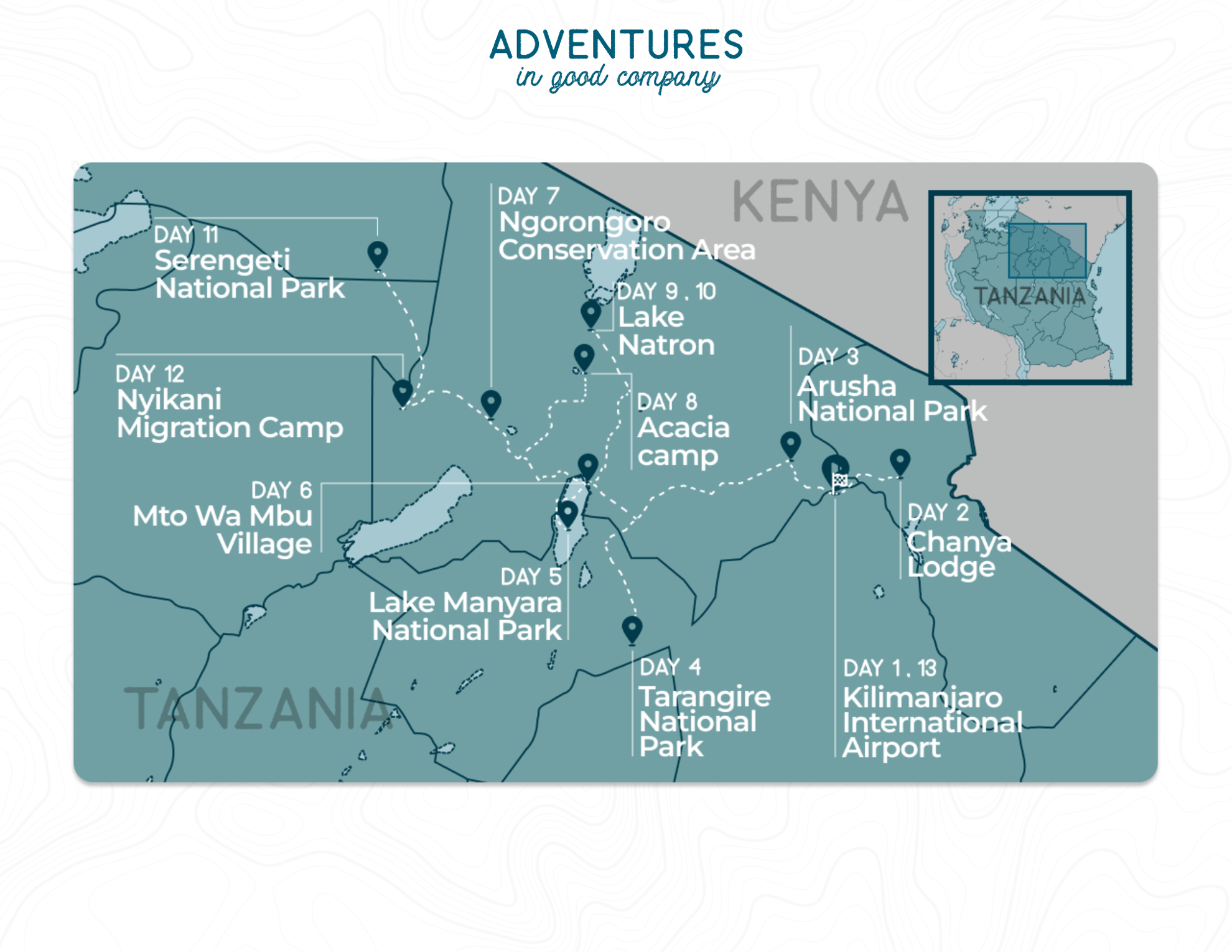
The group of woman were special, the 2 Tanzania Journeys guides were wonderful, The animals were incredible, the food was delicious.
Broad exposure to topography, flora/fauna and culture
Lainie the AGC guide was wonderful, Rama and Agray our Tanzanian tour guides were also incredible. The trip itself was a wonderful experience and going with a trusted organization like AGC helped make it special.
The local guides really made this trip special. Agreey especially shared a tremendous amount of knowledge about the animals, culture and communities.
The authenticity of the experiences of this trip allowed me to fully experience and appreciate the remarkable nature and people of Tanzania. Our AGC and local guides each contributed to the intimate and immersive nature of the trip.
| Departure Date | Availability | Price | |
|---|---|---|---|
|
September 15 to September 27, 2025 |
Available |
$10795.00 |
|
|
June 15 to June 27, 2026 |
Available |
$11795.00 |
Turn any trip into a private experience for your group, or let us design a custom itinerary just for you! Whether it’s friends, family, or colleagues, we’ll make your journey unforgettable.



